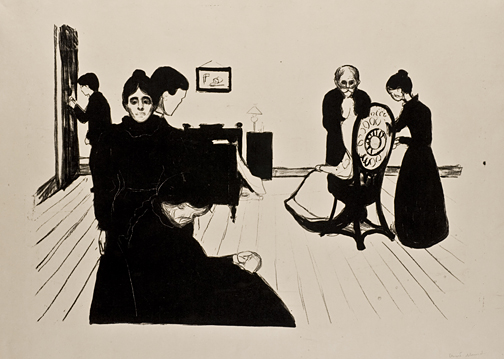How human disease has been represented in art through the ages is the subject of the exhibition titled “What’s Wrong With Me? Art and Disease,” which will open Friday, April 22, in the Toledo Museum of Art Hitchcock Gallery.

“Sterbezimmer” (“The Death Chamber”), 1869 lithograph by Edvard Munch, Toledo Museum of Art. Fredrick B. and Kate L. Shoemaker Fund, 1976.139.
“After learning about the history of disease, students get to know related objects in the Toledo Museum of Art’s permanent collection in the process of designing their own exhibition,” said Dr. Mysoon Rizk, UT associate professor of art history, who is teaching Exhibition: Art and Disease.
“The class has taught me so much — that the existence of disease played an integral part of our history, culture and art,” said John DuVall, a UT student taking the class. “By studying the way people afflicted with disease have been stigmatized and isolated throughout history and in our lifetime, society as a whole still has much to learn regarding compassion for the sick.”
Visitors in the early weeks of this exhibition will see an “installation in progress” as the eight students continue their work through the remainder of spring semester. The completed exhibition will remain on view through Sunday, Aug. 7.
Three themes emerge from the selected works: disease is part of life; isolation and social stigma have accompanied various diseases at different times in human history; and disease can inspire hope, faith and compassion for one another.
Thirty-one works of art, including prints, three-dimensional objects and a video, are shown. All but one object are from the museum’s collection.
Some of the artists have had firsthand experience with disease, and their works express emotions that include anger, grief, compassion and hope, resulting from their encounters with illness.
“Sterbezimmer” (“The Death Chamber”), an 1896 print by Norwegian artist Edvard Munch, was created after the artist’s sister died from consumption, now is known as tuberculosis.
A series of woodcuts by German artist Käthe Kollwitz relates to World War I and World War II. Kollwitz lost a son and a grandson in battle. Her work, “The Parents” from the “Krieg (War)” series, connects to everyone’s losses through war.
“The Good Samaritan,” an 1861 print by Rodolphe Bresdin, is a reminder of the strength of human compassion.
Art relating to disease can be found from every period and reflects common beliefs of those times, Rizk said. For instance, bloodletting was prescribed when people believed illnesses were caused by one’s body being “out of balance.” Bloodletting was thought to remedy the imbalance.
Stigmas associated with some illnesses, such as cancer, have decreased over time as our understanding of the diseases and effective treatments have grown. The stigma associated with AIDS, particularly in the 1980s when the syndrome was little understood and before treatments were developed, is gradually abating, she said.
“A Fire in My Belly” (1986-87), a 13-minute video version of an unfinished film by American artist David Wojnarowicz, is part of the exhibition. Visually powerful with images some may find disturbing, the video depicts the inevitability of death as well as the artist’s anger and grief after losing many friends to AIDS-related illnesses, of which he, too, would die. The work is on loan from the PPOW Gallery in New York.
The free exhibition is made possible by members of the Toledo Museum of Art and supported in part through the sustainable grant program of the Ohio Arts Council.
The Toledo Museum of Art is open from 10 a.m. to 4 p.m. Tuesday through Thursday, from 10 a.m. to 10 p.m. Friday, from 10 a.m. to 6 p.m. Saturday, and from noon to 6 p.m. Sunday. Admission is free.